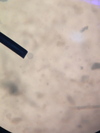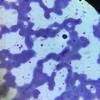Apicomplexans and Ciliate Flashcards

Balantidium coli (trophozoite)

Balantidium coli (trophozoite)

Balantidium coli (cyst)

Toxoplasma gondii (tachyzoites)

Toxoplasma gondii (tachyzoites)

Plasmodium falciparum (ring, trophozoite – note double chromatin dots)

Monocystis lumbrici (trophozoite)

Monocystis lumbrici (trophozoite)

Plasmodium falciparum (gametocyte)

Plasmodium vivax (ring, trophozoite)

Blastocystis hominis

Plasmodium vivax (ring, trophozoite – note Schuffner’s dots)

Plasmodium vivax (ring)

Plasmodium vivax (trophozoite)

Plasmodium vivax (schizont)

Plasmodium falciparum (ring – note double chromatin dots)

Plasmodium falciparum (ring – note multiple infections)

Plasmodium falciparum (gametocyte – note banana shape)

Plasmodium falciparum (early schizont)

Plasmodium ovale

Plasmodium spp. (exflagellation, microgametes)

Plasmodium spp. (sporozoites from salivary gland)


































